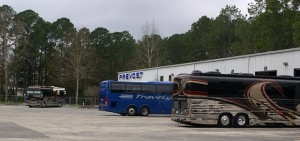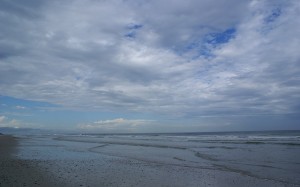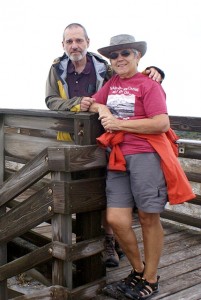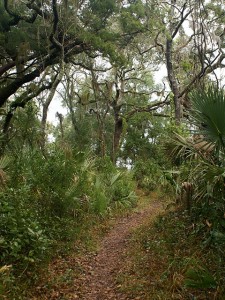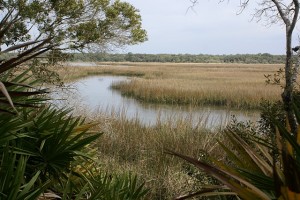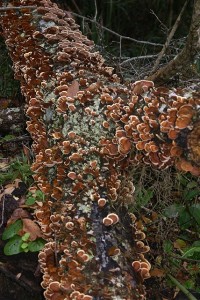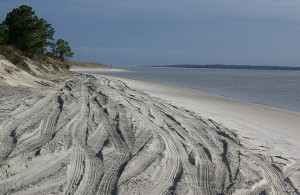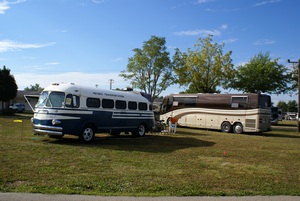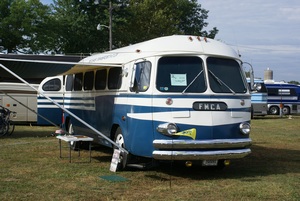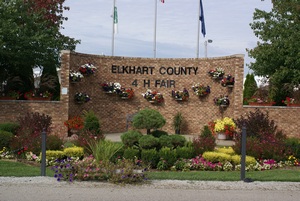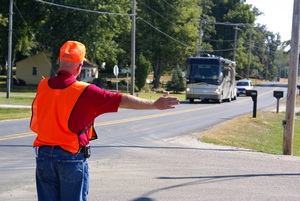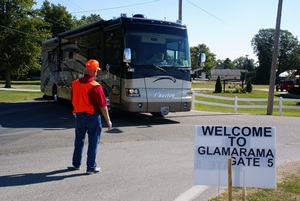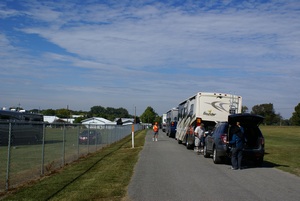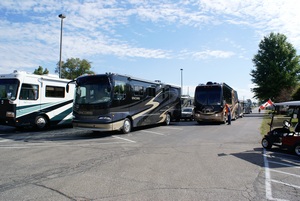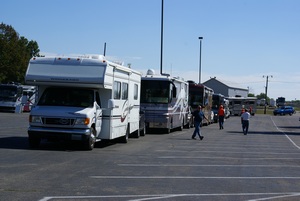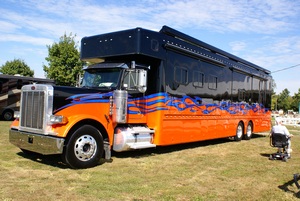Although I went to bed late last night I was awake at 7 AM this morning and got up at 7:30 to find the rally venue shrouded in dense fog. Linda was still sleeping at 8 AM so I put some of my non-dairy soy coffee creamer in one of our FMCA insulated flip top travel mugs and walked over to the activities building. There are 82 rigs at the rally with close to 160 people and I estimated that 50 of them were at breakfast when I arrived. Some folks had probably been there at 7 AM when breakfast started and left before I got there. Others, including Linda, showed up after me but before breakfast ended at 9 AM. Breakfast was a simple, self-serve, affair at this rally: donuts, bagels, cream cheese, orange juice, and coffee, both regular and decaf. Coffee and a toasted bagel, dry, works for us.
We chatted with Frank Noehl and Jim Seagraves, both members of our FMCA GLCC chapter, and were eventually joined by Jerry and Rose Mary Campbell. Jerry and his parents (Jack and ?) have MCI 102C3 motorcoaches that they converted to Detroit Diesel Series 50 engines from the 2-cycle engines that were original to them. There are two other MCI coaches here with the same engine conversion, and Jack was the driving force behind all four of these repowers. The four buses are parked together and I was interested in hearing more about this process.
The DD Series 50 is basically the same engine as the Series 60 but with four inline cylinders rather than six. I chatted with Jerry yesterday and had a look at his engine bay at that time. It’s a nice installation; a bit tight in spots but it fits. The 50 Series engine was used in transit buses and local delivery trucks but not in long-haul trucks or motorcoaches. Jerry’s engine is rated at 350 HP and 1200 lb-ft of torque. That’s essentially the same torque we get from our DD 8v92TA but 100 less horsepower. I seriously doubt that this would be an adequate engine for our Prevost H3-40 VIP conversion, but it is an intriguing idea should we ever need to replace our 8v92. The Series 50 and Series 60 engines are 4-cycle, inline configurations and develop their torque at lower RPMs than the 2-cycle 92 Series engines and cruise at highway speeds at lower RPMs. They are also designed to work with the newer Allison “World” transmissions.
We were back at our coach by 9:30 AM. The temperature was still in the 70s, if not by much, and there was a stiff breeze so it was actually pleasant sitting in the shade under our patio awning. We had PB&J sandwiches for lunch with Halo orange segments and Snyder Sourdough Pretzel Nibblers. The day eventually heated up, however, and I went inside to work at my computer while Linda went for a walk. I edited the blog posts for September 26 through 30, 2015, turned on our Verizon Mi-Fi, and uploaded them to our WordPress site. Linda got back and stayed inside to read while I took the camera and went out to photograph the buses and other RVs at the rally.
Even with partly cloudy skies the sun was very hot and many of the rigs were not in good light. And even though they were parked with a generous amount of space between them they were still close enough together to make good photos a challenge. Folks also tend to have their toads parked in front of their rigs, making good photo vantage points just that much more difficult to find.
As I was photographing I was approached by someone who introduced himself as Dave Aungier. He said he had read all of my BCM articles and enjoyed them and wanted to write one about his bus but needed help with the photos. That is a much easier situation for me than actually writing an article about someone else’s bus. His 1977 MCI MC-5C was parked between two open-sided buildings where I could not get good exterior photos. Like most of the attendees he plans to leave Friday but will not be in a hurry to do so and is willing to pull his bus out into the open grassy boondock area so I can photograph it. With any luck this will be an easy collaboration.
I got pictures of most of the rigs except the back/east row. On my way over there I stopped to chat with Jimmy Clay and his brother-in-law Ronnie Mewbourn and Ronnie’s wife Diann. They were here two years ago when I photographed Jimmy and Sadie’s Iron Horse Eagle conversion, which ran as the featured bus in the April 2014 issue. After chatting a while we agreed that I would come back tomorrow with a notepad to get Ronnie and Diann’s “story” and possibly some interior photos of their 1968 Model 07 Eagle conversion. They also plan to leave on Friday but will not be in a hurry to pull out and agreed to move their bus out into the grassy boondock area if needed so I can photograph it.
By the time I got to the eastern most row of buses, most of which are facing east, it was almost 4 PM and the sun was behind them and in my face eliminating the possibility of good photos. I will try to shot them early tomorrow morning, weather permitting.
Dinner was at 5 PM. Bill and Brenda included a mini salad bar as I had suggested so we were able to have a large plate of shredded lettuce with sliced cucumbers, shredded carrots, cherry tomatoes, and garbanzo beans. They also had a bottle of balsamic vinaigrette dressing just for us.
Master of Ceremonies John Vickery handed out the door prizes and the recipient of the second set of Bus Conversion Magazines was Ken Siems. The entertainment for the evening was the karaoke trio, Shake, Rattle, and Soul, doing oldies. They were OK and given the typical age of the rally attendees, which was older than us, those who stuck around knew the tunes and enjoyed hearing them again. They performed from 8 to 11 PM and I presume they were much less expensive than an actual live band.
As of this evening no one had stepped forward to take over the rally from Bill and Brenda. It occurred to me that not only is it a lot of work to organize a rally, there is financial risk involved. Live entertainment, or even a DJ, require non-refundable commitments far in advance, especially for dates like New Year’s Eve. You also have to book a venue and put a deposit on it, and you have to incur these expenses without knowing how many people, if any, will actually show up. Most bus nut are not in a position to incur that kind of financial risk, and the upside potential is small to non-existent. Nick and Terry Russell, of The Gypsy Journal, are very savvy business people but gave up doing The Gypsy Journal Rallies because they were losing money on them even with the assistance of a small army of dedicated volunteers. Sad, but true.
Although they are not the same kind of experience, one of the things that is emerging in place of these larger, organized, fee-based, rallies are “non-rally rallies.” RVillage calls them “Get-Togethers.” Someone picks a time and place and sends out word. Everyone is responsible for their own camping fees, if any, and there are no planned meals, entertainment, or seminars. Entertainment and seminars, if any, are strictly impromptu participant-driven events. There might be some “pot-luck” (carry-in) community meals, but not necessarily, and they are typically not prearranged. Basically, the event is not really hosted or sponsored by anyone, there’s no organizing that takes place, and there is no group, couple, or individual that has any liability for what happens.
